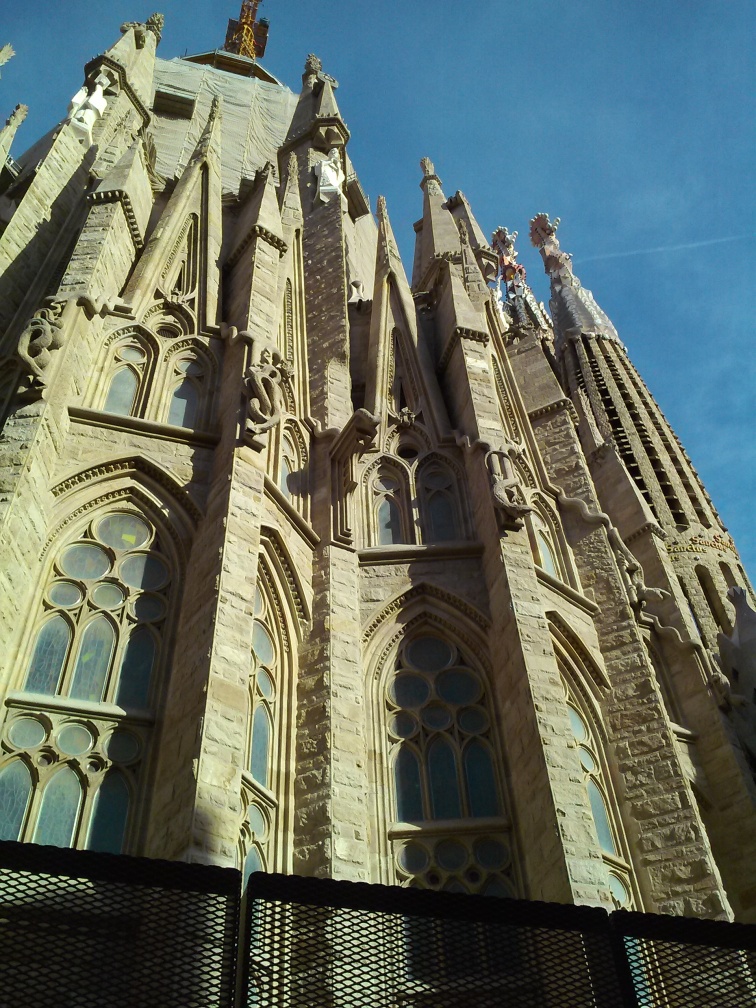Visiting this massive, dream-like, gorgeous building inspired so many thoughts about Catholicism, nature, science, and the evolution of Western philosophy that I decided to blog about it, nerd that I am. It’s not meant to be an academic paper, just some philosophical musings which might inspire you to visit this place. Or, just to Google it a bit more and find some better photos of it on the internet for your own musings…
The first thing I noticed here is the immense size of the building and the cranes towering over it. The cathedral is unfinished, and costing millions of Euros every year to continue the work. Admission is being charged at 20 Euros per ticket to fund the construction. I hope they finish it in my lifetime… yes I would come here again and pay 20 Euros to get a chance to peek inside. There’s a thriving selfie- stick cart in front of the building… you can’t really get away from commerce in these times. I knew better than to try for a selfie because looking at my distorted chin in front of a massive graceful monument isn’t my idea of a great photo.
The next thing I noticed at the Sagrada Familia was a blend of old and new, reality and dreams… Classic Gothic windows and towers in some sections contrast with lines of non-straight, perspective-changing pillars. Sharply detailed saints, snakes and lizards perch high on the walls while less detailed, blocky figures are displayed below.

To any child raised Christian, we know the snake as a symbol of evil. The snake was the form which Satan took to tempt Eve into eating the forbidden fruit. She offered the fruit to Adam without telling him its origin from the forbidden tree and so they both were cast out of the Garden of Eden. This story has always bothered me! I was born with a passion for fairness and feminism; this story that “Man’s fall from Grace” comes from “A woman’s deceit” seems so… blaming. So false. It’s clearly a story in which men refuse to take the blame for their own failings. It’s a story which encourages men to disgrace women and hate snakes, avoid responsibility and in so doing, belittle the power and the wisdom of their own sex. Here on the Sagrada Familia cathedral, (which translates to Sacred Family), both women and snakes are clearly forgiven in Gaudi’s version of Genesis. He seems to be saying that all creatures are sacred, do not cast down the women and the snakes because you are dishonoring your own family. Instead, celebrate them as different aspects of God’s love, God’s beauty, God’s grace and power. The lizards may represent dinosaurs, which says to me: yes you can still be a Christian and still appreciate the stories told in the fossil record in our Earth’s crust.
High up on the towers are figures which look like molecules… I think that these shapes are meant to be halos or crowns for the crosses on the front of the building. To me, they represent an embrace of the physical sciences. They seem to be saying, there is no reason to believe that the old Christian God is not also a God of molecules and space. You do not have to turn against scientific knowledge in order to embrace the Catholic faith. This message fills me with hope since so many Christians in America denounce science and deny climate change, during a time when global warming and overpopulation are increasing at alarming rates.
Pope Francis gave President Trump his personal treatise on climate change during the President’s visit to the Vatican and the timing of this, plus my recent visit to this science-embracing cathedral give me a lot of hope for the future of Christian thought. I believe that scientific inquiry does not lead you to either believe or disbelieve in God; it just leads you to a better understanding of the universe in which we exist.

On this side of the building you can see a number of blocky figures including a block-headed Christ. In my study of art, and in my learning about photography through editing the Accordion Babes calendar with the help of talented photographers, I’ve learned that a great artist manipulates the level of detail in the composition on purpose in order to create a scene in which the user is drawn to certain details more than others. It’s very interesting to me that the saints perched above are in sharp detail while Christ and the Apostles are blocky. Though he’s clearly in the center of this part of the composition, the crucified Christ is blocky in the head while his lower body and his penis are in sharp detail. Gaudi seems to be saying: there are many details missing about the life of Christ. We know he was a man with all the body parts which define a man… we don’t know what his face looked like. Once again I feel a sense of forgiveness from Gaudi while watching the face of this building. Don’t worry, Christian man, you have a penis and it tries to get you in trouble sometimes. So did Christ…

This is not the greatest photo but it does show you how the pillars towering over Christ have perspective-breaking qualities. They are not straight up and down at all, rather, leaning back, rising… instead of straight columns the entire edge is a curve. There are many details like this on the cathedral… things which give you an illusion of straightness from one angle and a shifting, curving perspective from another angle. This seems to represent the obliqueness of thought and understanding to me. You can look at any simple fact from a different perspective, and instead of finding straightforward answers you can find yourself admiring a non-linear, dreamlike fantasy of new knowledge.
I hope this little description brings both my science-loving atheist friends a deeper appreciation of religion; and my Christian friends to embrace the beauty of scientific thought. It’s just a blog so… at least I hope you enjoy the pictures and get a little sense of the beauty of the Sagrada Familia.
-Renee


I think that you would truly appreciate the writings of Richard rohr. He is a Franciscan who espouses many of your same thoughts.